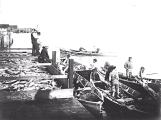1
The waterfront of Steveston was known for many years as Cannery Row. At the height of operation there were as many as fifteen canneries along the shoreline. They provided jobs for thousands of people and made Steveston the "Salmon Capital of the World".3
ENGLISH'S PHOENIX CANNERYIn 1882 the Municipality of Richmond issued its first two trade licenses: one to J.H. Todd and Sons for the Richmond cannery on Sea Island and one to Marshall English for the Phoenix cannery on the South Arm of the Fraser River near Steveston. Marshall English bought this land from Elzear Gerard and built a house for his family there too. The building at the left end of the wharf became the Lulu Island Post Office in 1884, saving pioneers a frequently difficult trip across the river to Ladner to collect mail. It was later used as the area's first school. English's wife, Mary Frances, and his daughter, Virginia, taught Walter Steves and other early settlers there.
5
GARRY POINT CANNERY AND CITY WHARFIn 1880 Manoah Steves' son, William Herbert Steves, bought 160 acres west of Number 1 Road between Steveston Highway and Chatham Street with a mortgage from B.C. Lands and Investment. He borrowed an additional $41,000 at 12% interest to buy the 55 acres of waterfront south of Chatham Street and began to develop the townsite known as "Steves". Herbert Steves and Marshall English, who owned waterfront land immediately east of Number 1 Road, built a wharf called Steves' Landing or City Wharf at the end of Second Avenue. From left to right, this picture shows the Garry Point Cannery, City Wharf and shed, Herbert Steves' seed store, and the Rubinowitz General Store.
7
BRITANNIA CANNERYBritannia cannery, built in 1890, was purchased in 1891 by the ABC Canning Company. The building was L-shaped with many windows for light, and high lofts for storing empty cans and nets. From here the first direct shipment of canned salmon was loaded for Europe aboard the tea clipper TITANIA. Fishermen's gillnets were hung on net racks on planked wharves built on wooden pilings. Cannery owners paid Native women to make gillnets from linen imported from Ireland. Nets were 900 feet long and 12 to 18 feet deep with a cork line at the top and a lead line on the bottom. Each cost about $150 to make. Britannia was converted to a shipyard in 1918 and used until the 1970's. It is now a heritage site belonging to the City of Richmond.
9
GULF OF GEORGIA CANNERYThe ABC Canning Company sold the Garry Point cannery to Charles Windsor for $5,000 in 1893. Windsor formed a company with Oswald Malcolm and George Wilson, enlarged, and renamed the cannery. With 2 canning lines, the Gulf of Georgia cannery (also called Malcolm and Windsor cannery) was the largest cannery on the west coast until 1902, earning the nickname "the monster cannery". By 1895 there were 12 canneries operating on the Steveston waterfront: Atlas, Gulf of Georgia, Star, Steveston, Lulu Island, Brunswick, Imperial, Phoenix, Britannia, Pacific Coast, Beaver and Canadian Pacific. The Gulf of Georgia cannery became a National Historic Site in 1976 and is now a museum.
11
STEVESTON CANNERY ROWFrom right to left are the Britannia, Phoenix, Dumfries, London, and Garry Point canneries. In 1891 the Anglo-British Columbia Packing (ABC) Company paid $300,000 for 9 of the 26 canneries in B.C., including the Garry Point, Phoenix and Britannia canneries in Steveston. Henry Ogle Bell-Irving organized this company and hired Marshall English to supervise the 3 Steveston plants. Each cannery was assigned 20 boat licenses and employed about 80 fishermen and 150 cannery workers. The ABC Company built the Dumfries cannery next to the Phoenix in 1891 to qualify for 20 more fishing boats but never canned there. Both the Dumfries and the Phoenix were destroyed by fire on July 3, 1895, but the Phoenix was rebuilt in 1897.
13
SAILING SHIPS IN STEVESTONIn September 1889, the Hudson's Bay Company tea clipper, TITANIA, carried the first direct shipment of canned salmon from Britannia cannery in Steveston to London, a trip around Cape Horn, that took 104 days. Before this, salmon cases had been delivered to Victoria by stern-wheelers before being shipped to Europe. By 1895 the canneries in Steveston were producing approximately 200,000 cases of salmon annually. That year, in one week, 14 windjammers waited near Steveston for appropriate tides and westerly winds to dock. Crews unloaded ballast of rocks from their ships' holds and filled the space with lumber and canned salmon. Those rocks were used to build roads and dikes in Richmond.






